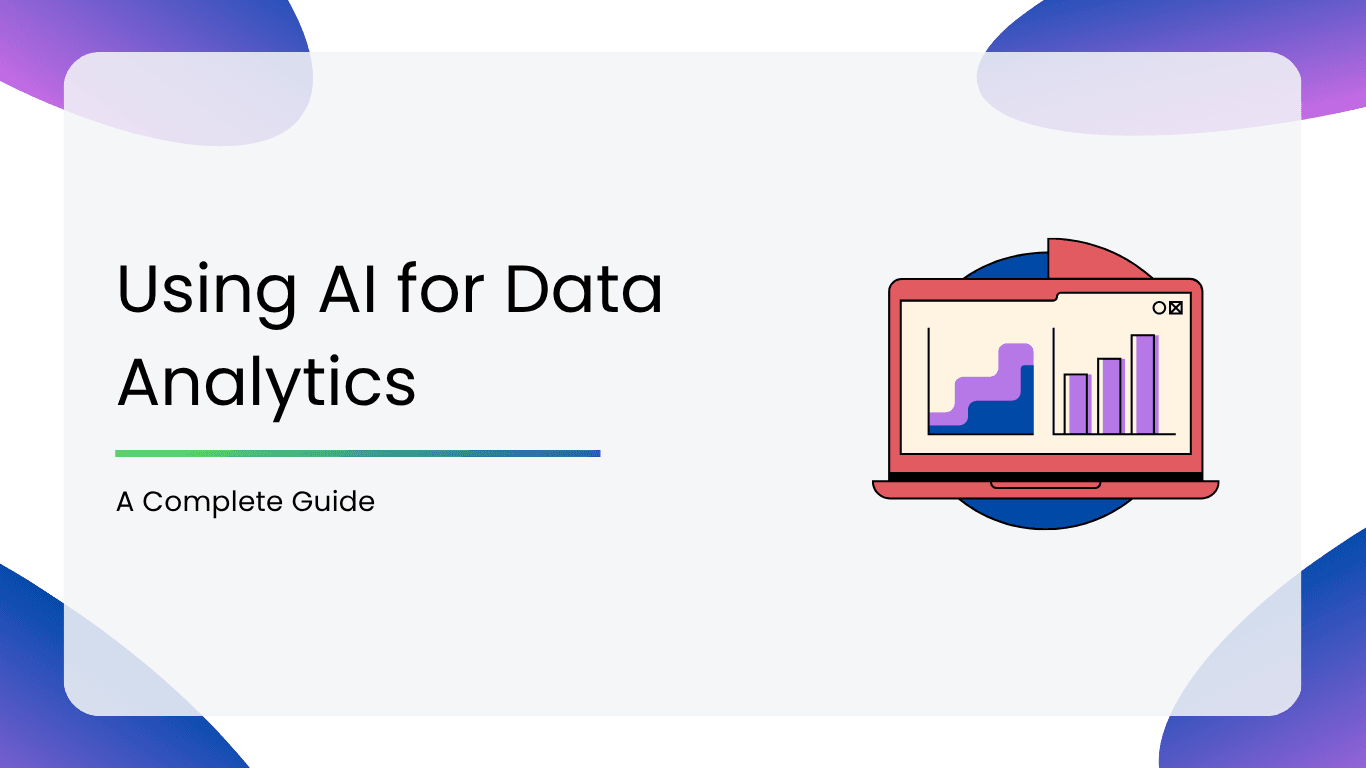Whether you’re a marketer, analyst, founder, or someone just trying to make sense of endless spreadsheets, AI is transforming the way we understand and use data. What used to take days can now be done in minutes with the right AI tools.
Data analytics has always been about finding insights, spotting patterns, and making smarter decisions. But imagine manually crunching all those numbers, building models, and cleaning data. Sounds exhausting, right? This is where AI steps in.
If you’ve ever wished for a smarter, faster, easier way to analyze data, then this guide is for you.
What is AI in Data Analytics?
At its core, it’s the use of artificial intelligence to help process, analyze, and interpret large sets of data quickly. Instead of manually combing through thousands of rows in Excel or building complex formulas, AI does all the work.
So this is what you get:
- Cleaning messy data without spending hours on formatting errors
- Predicting future trends based on past behaviors and current patterns
- Identifying insights you may not even know to look for
- Generating reports in real time, with visuals and summaries ready to go
AI takes the traditional approach to analytics, including collection, cleaning, analyzing, visualizing, and adds a layer of intelligence to make the process smoother, smarter, and way more scalable.
Traditional Analytics vs AI-Driven Analytics
| Feature | Traditional Analytics | AI-Driven Analytics |
| Data Handling | Manual cleaning and input | Automated data preparation and anomaly detection |
| Speed | Time-consuming, especially with large datasets | Lightning-fast, even with massive data volumes |
| Insight Generation | You ask the questions, and it gives answers | It finds patterns and surfaces insights you didn’t ask for |
| Forecasting & Prediction | Based on static historical trends | Uses machine learning to predict outcomes in real time |
| Scalability | Gets slower with more data | Built to scale with your data growth |
| Skill Requirement | Requires technical skills and manual effort | More user-friendly, even for non-tech users |
| Decision Support | Reactive: tells you what happened | Proactive: tells you what will happen and what you should do next |
Top 9 Ways to Use AI for Data Analytics
So, how exactly does AI make your analytics smarter, faster, and more actionable? Here are 9 real-world ways AI is changing the data game.
1. Predictive Analytics
AI models can analyze past behaviors, seasonality, customer trends, and real-time signals to forecast what’s likely to happen next. Whether it’s projecting next quarter’s sales, predicting product demand, or anticipating customer churn, AI helps you stay one step ahead.
AI keeps learning. The more data you feed it, the sharper its predictions get.
2. Automated Data Cleaning & Preparation
80% of data work is cleaning up typos, duplicates, missing entries, weird formatting, etc. This process gets automated using AI. It can detect outliers, fix inconsistencies, handle missing values, and even transform unstructured data into something you can actually work with.
This saves hours wasted fixing spreadsheets before you even get to the analysis.
3. Natural Language Processing (NLP) for Text Analytics
With AI-powered natural language processing, you can scan thousands of text entries in seconds, identify sentiment, detect common issues, and uncover trending topics. If you want to know what people really think about your latest campaign or product update, NLP shows you patterns, tone, and keywords.
AI turns unstructured clutter into structured data.
4. Image and Video Analysis
Using AI-powered image and video analysis, you can automatically detect patterns, track movement, recognize objects, and even assess product quality in real time. So, no more manual reviewing, AI sees it, analyzes it, and delivers insights instantly.
For example, in retail, AI might spot empty shelves. In healthcare, it can assist in diagnosing conditions. In manufacturing, it could detect defects before they hit the production line.
5. AI-Powered Dashboards & Visualization
AI-powered dashboards don’t just visualize data; they highlight trends, flag anomalies, and even suggest what actions to take next. You can log in and see an auto-generated summary of what’s happening.
For example, “Sales are down 12% in region B. Customer engagement dropped after Campaign X.”
6. Real-Time Analytics & Decision-Making
AI brings real-time analytics to the front, as in, processing data as it happens and triggering decisions at the same time. It’s instant, intelligent, and always on. Whether you’re forecasting inventory or monitoring user behavior, real-time AI keeps you one step ahead of the curve.
For example, dynamic pricing that adjusts based on demand, logistics systems that reroute deliveries mid-route, or servers that self-serve before anything crashes.
7. Anomaly Detection
AI-powered anomaly detection scans your data continuously to spot anything unusual, like a sudden drop in sales, a spike in server errors, or a pattern that indicates fraud. AI detects abnormalities and flags them for your review.
It’s fast, scalable, and always a few steps ahead.
8. Conversational Analytics with LLMs
Conversational analytics lets you type questions like, “What were our top-performing campaigns last quarter?” or “Why did traffic drop on mobile last week?” You get clear, actionable answers without having to go through dashboards.
You get instant, intuitive insights. If you can ask it, AI can answer it.
9. Generative AI for Data Storytelling
AI can automatically generate clear, written summaries that explain what the data means, what changed, and what to do next. It presents data like a story: easy to share, easier to understand, and impossible to ignore.
For example: “Website traffic increased by 18% this week, primarily driven by organic search. Conversion rates held steady, but mobile bounce rates rose slightly.”
Key Benefits of Using AI in Data Analytics
Here are some benefits that make AI a total game-changer in Data Analytics
1. Faster Insights
AI gives you instant clarity by delivering real-time insights the moment new data comes in. This means quicker decisions and a serious edge over slower competitors.
2. Reduced Manual Errors
AI automates data preparation and analysis, cutting out the risk of human error. Fewer mistakes mean more reliable insights and more confident strategies.
3. Scalable Decision-Making
AI handles massive datasets with ease, spotting trends across millions of rows. It scales effortlessly, helping teams make accurate decisions at any size.
4. Personalized Business Intelligence
From marketers to CFOs, everyone gets insights aligned with what matters most to them. It’s like having a custom data assistant that speaks your business language.
Best AI Tools for Data Analytics in 2025 (Quick Overview)
Here’s an overview of the top tools making waves in AI-powered data analytics this year:
1. Microsoft Power BI
Power BI remains a favorite for businesses already using Microsoft tools like Excel, Teams, or Azure. Its 2025 update includes deeper AI capabilities through Microsoft Copilot, which allows users to interact with data using natural language queries. You can ask questions like, “Which product sold the most last quarter?”, and get a visualized answer instantly. Power BI also offers real-time dashboards, automated workflows for reporting, and enterprise-grade security features.
2. Tableau
Known for its visually striking dashboards, Tableau now packs even more power thanks to its integration with Salesforce’s Einstein AI. In addition to drag-and-drop dashboard building, users can now run predictive analytics and get AI-powered trend forecasts. It also supports natural language queries via “Ask Data,” which makes it accessible to non-technical users. Tableau’s strength lies in its balance between simplicity for beginners and depth for power users.
3. Sisense
Sisense stands out for its ability to embed analytics directly into other applications, making it perfect for SaaS products, internal tools, and customer-facing platforms. It offers a full API ecosystem, AI-powered insights through its Compose SDK, and strong real-time data processing. Sisense is developer-friendly, with robust customization options and backend flexibility.
4. Polymer
Polymer is designed for business users who want to make data-driven decisions without needing to write code. It uses AI to automatically generate dashboards from raw data, and its natural language query feature makes exploring trends as easy as typing a question. Whether you’re in marketing, sales, or product, Polymer simplifies data exploration with intuitive visualizations and pre-built templates.
5. Qlik
Qlik offers a unique associative data engine that enables users to explore relationships in data from multiple sources without being restricted to predefined queries. Its Active Intelligence model delivers real-time updates and AI-powered insight suggestions, helping users uncover trends as they emerge. Qlik also provides enterprise-level data integration and flexible deployment options across cloud and on-premises environments.
6. Domo
Domo is built for fast, cross-functional collaboration. It excels at connecting hundreds of data sources and turning them into real-time dashboards that can be accessed across teams. With built-in communication tools, low-code automation, and a sleek mobile-first experience, Domo makes it easy to translate data into action. It’s a great fit for those who want to monitor KPIs on the go and act on insights quickly.
7. Alteryx
Alteryx is a powerful platform for data preparation, analysis, and machine learning. Analysts can automate entire workflows, from cleaning data to generating predictive models, without writing code. For more advanced users, it also supports R and Python scripts. Alteryx is perfect for organizations that want to empower non-tech users to build complex data pipelines and leverage AI, while still offering room for technical customization.
8. Altair RapidMiner
Altair RapidMiner combines data analytics, AI, and automation under one platform. It includes tools for building generative AI applications, automating the extraction of unstructured data, and deploying AI agents that can monitor systems and make decisions. It is ideal for enterprises looking to modernize legacy systems and unlock deeper insights from previously inaccessible data.
9. Bardeen
Bardeen is a no-code automation platform designed to streamline repetitive data tasks. It excels in web scraping, automated data organization, and syncing results to tools like Google Sheets, Notion, or CRMs. With easy functionality and custom workflow options, Bardeen saves time, reduces manual effort, and eliminates the need for repetitive copy-paste work.
If you want to deep dive into each of these tools, make sure you check out our blog “9 Best AI Data Analysis Tools in 2025”
Best Practices for Implementing AI in Analytics
Ready to bring AI into your workflow? Here’s what you need to do:
1. Ensure Data Quality and Security
AI is as good as the data you feed it. Clean, accurate, and well-structured data is non-negotiable, and so is keeping it secure. Invest time in setting up strong data governance and privacy protocols from day one.
2. Combine Human and Machine Intelligence
AI can crunch numbers and spot patterns fast, but it still needs human judgement. Pair your algorithms with domain experts who can validate outputs and apply context.
3. Train Models with Diverse Datasets
Bias happens when your training data doesn’t reflect the full picture. Make sure your datasets are inclusive, varied, and representative of real-world conditions. This leads to smarter models and fairer outcomes.
4. Use Explainable AI for Transparency
Prioritize tools and models that offer explainability, so teams can understand how decisions are made. This builds trust and makes it easier to troubleshoot or justify AI-driven insights.
5. Start Small: Pilot Projects First
Don’t make everything AI-centric at first. Begin with one use case, a pain point or repetitive task that’s easy to measure. Once you see wins, scale it up.
The Future of Data Analytics with AI
Here’s what’s coming next in the world of data and intelligence:
1. Autonomous Analytics
Imagine dashboards that update themselves, detect anomalies, and recommend actions without being asked. That’s where we’re headed with more autopilot insights.
2. Integration with No-Code Tools
No-code platforms are bringing advanced analytics to marketers, operations heads, and founders, without a single line of code. You can expect easier adoption and faster experimentation for non-tech users.
3. AI Agents for Proactive Insight Generation
From spotting drops in sales to predicting customer churn, these smart assistants will monitor, alert, and even suggest fixes automatically.
4. Ethical Concerns & Data Governance
As AI gets more involved in decision-making, issues around data bias, transparency, and consent become critical. Organizations will need to double down on ethical AI, fairness, and strong governance frameworks.
AI tools are more accessible than ever. From cleaning messy spreadsheets to predicting customer behavior, AI is transforming how teams work, think, and make decisions. Start small, explore the right use cases, and let AI do all the complex work. This way, you can focus on what really matters: strategy, creativity, and impact.
The future of data is fast, smart, and a lot less manual.
Curious to know what else AI can do? Check out our other blogs:
- Best AI SEO Tools & How to Use Them
- AI A/B Testing: How You Can Optimise Using AI
- Top AI Tools for Digital Marketing (Free and Paid)
FAQs
Yes, many AI analytics tools today are designed with non-technical users in mind. They offer no-code interfaces and natural language querying, so you can generate insights and automate tasks without writing a single line of code.
A simple AI workflow could look like this:
– Import your raw data
– Let AI clean and organize it automatically
– Use built-in visualizations or dashboards to identify patterns
– Act on those insights, like launching campaigns, adjusting pricing or optimizing operations
Yes. Most modern AI analytics platforms come with hundreds of integrations out of the box. You can usually connect Excel, Google Sheets, Shopify, CRMs, Notion, etc., in just a few clicks.
Start by choosing tools that prioritize data governance and security. Also, use explainable AI wherever possible, especially when making decisions that impact customers. And always review automated decisions with a human lens to avoid biased or opaque outcomes.





